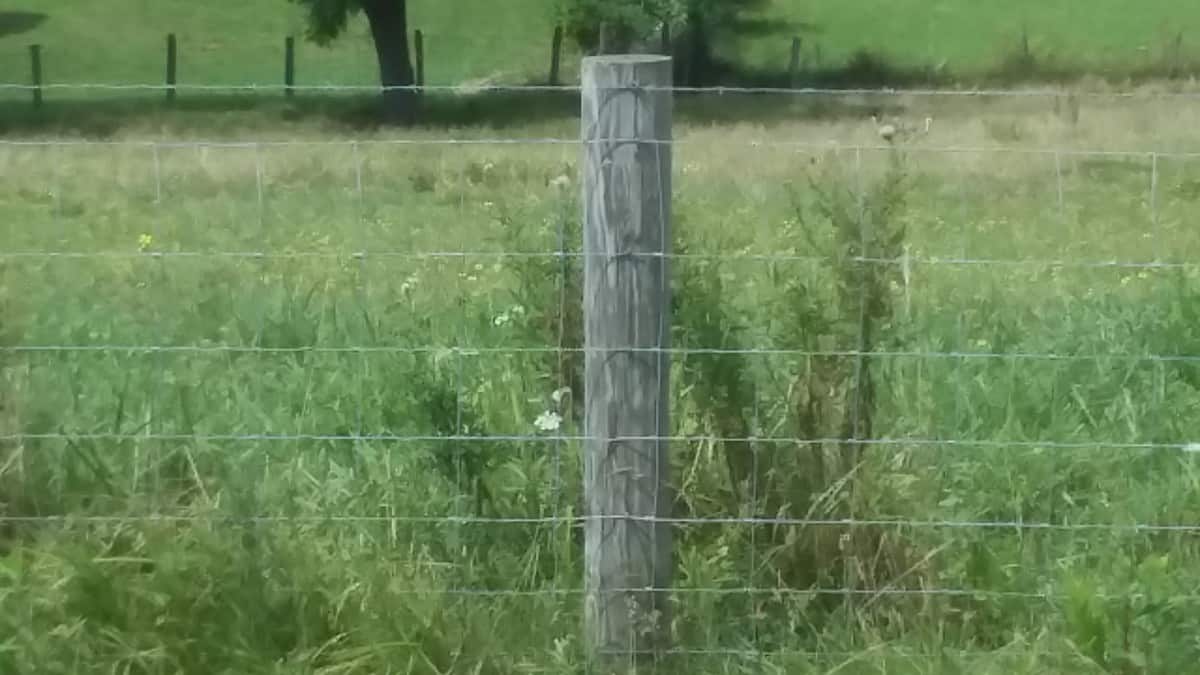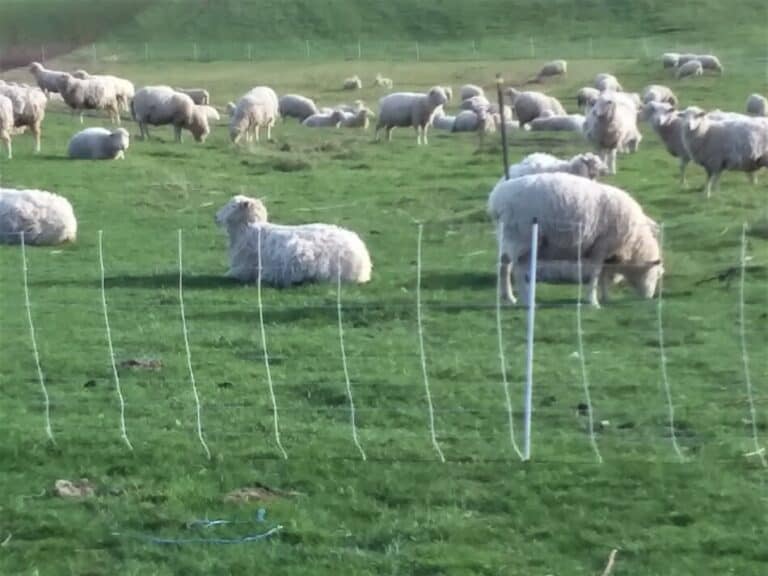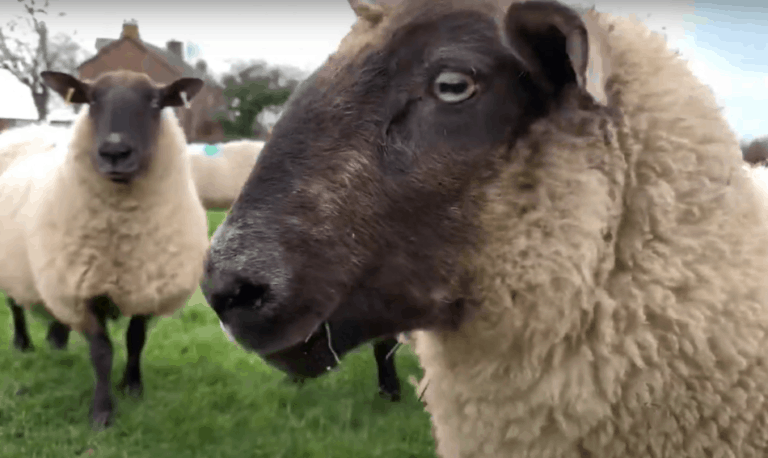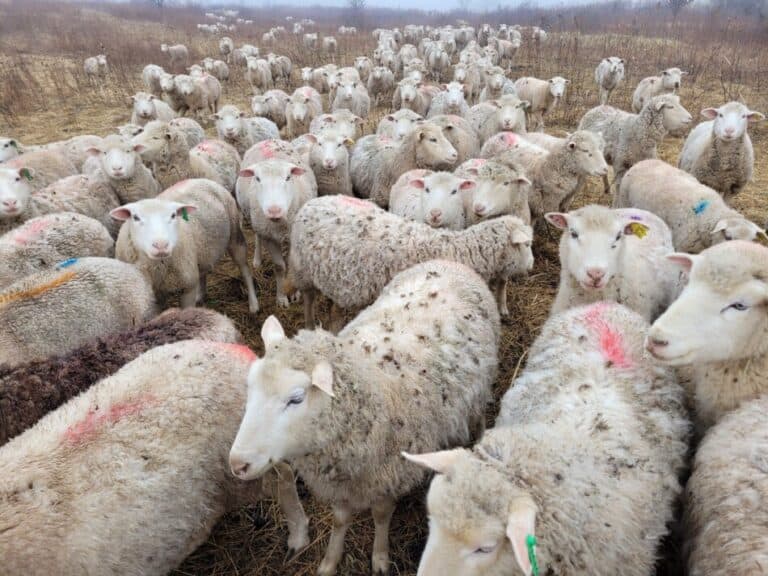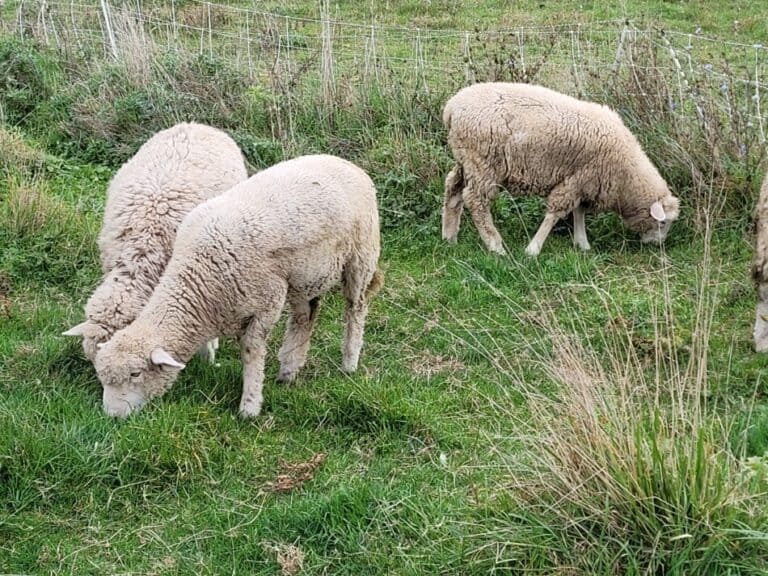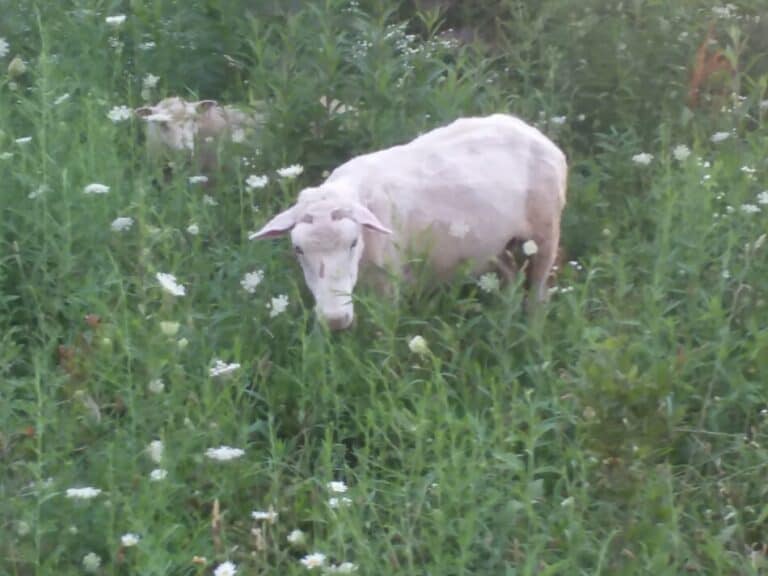Sheep Fencing: Pros And Cons Of Electric Vs Woven Wire

Sheep are not hard to keep in a fence. That’s the good news. Now you need to figure out which fence will work best for you.
For non permanent fence lines for your sheep use electric netting, since it is fast, easy and more affordable. For permanent fence lines for your sheep, use woven wire.
There are multiple options to keep your sheep where you need them. Options are great, now you can customize!
The one you choose depends upon your farm and how much money you want to spend and when you want to spend it.
ElectroNet 9/35/12 For Sheep goes over the good and bad of the electric netting we use everyday for our flock.
This article will give you a look at your options so you can decide the one, or combination of options that will work the best for you.
| Fencing situation | Electric Fence | Permanent Fence |
| You want to frequently move the flock’s fence line | Ideal | Hard |
| You want to put up the fence line once and never move it again | Not ideal | Yes |
| You need the most economical start to fencing for sheep | Yes, can start small | Can be cheaper per foot |
| You want the cheapest fence per linear foot | More $/linear foot and replace every 10 years | Yes |
Electric fence is great for sheep
One of the easiest ways to provide good fencing for sheep is to use electric fence.
You have many choices regarding manufacturer and design with basically two methods, single strand wire or polywire or electrified netting.
Electrified netting is the best sheep fence
Our favored method of electric fence for sheep is to use electrified netting. Electrified netting is the way to go for sheep, since you know it will work.
The netting works great as long as: it has power and is put up without too much sagging in between posts (the sagging is from uneven ground).
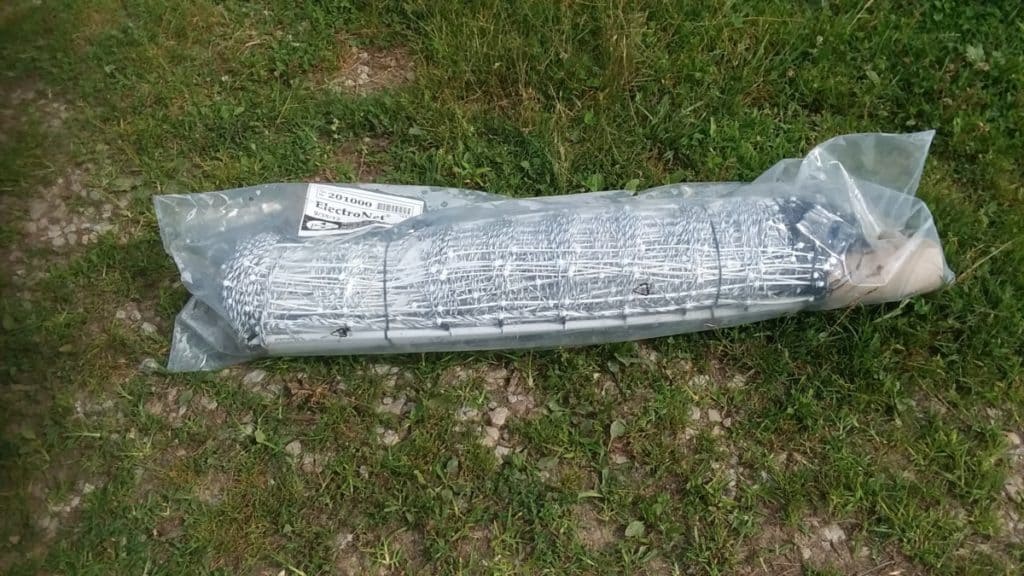
The main advantage to the netting over the single strands, is that netting is easy to move from place to place, since it is all one piece.
We had one sheep that would jump the netting this winter at a sagging spot, (frozen solid ground so no moving the posts), but other than her and it being frozen, the netting is super and reliable.
You just grab the posts in order and the netting kind of folds up as you go.
Is Electric Netting Worth It? compares costs of netting and more permanent fencing options.
If you need want to use single strands of electric wire or polybraid, you’ll need multiple single strands for sheep
You have single strand wire choices
A heads up before you get too far into this section: single strand wire of either type will not provide adequate fencing for your sheep.
The fence will have to be multiple strands. We have never had any luck with polywire/polybraid or regular wire fence for sheep.
For cattle it’s great, sheep no.
However, there are a few people making single strand electric for sheep work. A good example is Greg Judy of Green Pastures Farm in Missouri.
He has a website and a great YouTube channel, I’m a subscriber!
He shows how he keeps his sheep behind a single strand of wire, but listen carefully when he describes how he does it.
They are trained on a 3 strand fence that is smoking hot and they are never tight on grass (so they don’t want out).
In conclusion, single strand is being used by people grazing sheep, just not us.
Metal single strand fencing conducts better
The single strand wire can be just metal wire in a choice of gauges (thickness) or polywire/polybraid. There are advantages and disadvantages to both.
Metal wire strands I believe carry the most charge through through your fence network.
They also will be obvious when not carrying charge through the wire since it would be broken!
The disadvantages of metal wire is that moving it once it is set up is a frustrating task.
You can roll it back up on the reel but it will never fit back on there the same way it unrolled.
Moving wire is not something you would want to do very often.
Polywire/Polybraid single strand for sheep
Polywire is a small cable of plastic and metal strands woven together so the “wire” is flexible and very reusable.
A second option people who move a lot of fence prefer is polybraid, where the plastic and wire actually braided (not just twisted, together).
Polybraid is more expensive, but it seems to last nearly forever and does not snag when being pulled through brush or briars.
Polywire and polybraid would be used the same way so I refer to them both in this article as polywire.
Polywire can be rolled up and rolled out tons of times in it’s useful life. Moving polywire is easy compared to metal, you just roll it back up on the reel and unroll it when you get to where you want it next.
The main disadvantage to polywire is that it only carries the electric charge through the two metal strands that are woven into the polywire cable.
This can be an issue when the metal strands break off inside the polywire and will no longer carry charge through the line.
Small “hidden” breaks can ruin the fence
The tricky part here is that since the wires are small and hard to see in the cable unless you really get close.
You can’t easily tell when just taking a quick look at the line if there is a break.
Once you connect to the power and test the line at various spots you will know something is wrong, but it will take trial and error spot checking to find it.
I have to admit that we tend to reuse this stuff (polywire) over and over until it is really toast.
The more reliable answer here is to replace the polywire more frequently, once it shows the least bit of wear.
Then there is no question of an internal wire being broken and the line being less effective than a new one.
Polywire or polybraid are still not great for sheep, but if you kept only reliable lengths, you could be confident in them carrying the charge.
Electric fence for sheep has drawbacks
We use electric fencing for our farm, year round.
So we love it and feel like it is a great option, however there are a few drawbacks to electric that are not a concern with permanent fence like woven wire.
Electric fencing needs reliable power
The first drawback is the power thing, as in the fence needs to have power to work.
Sometimes chargers get hit by lightening or just stop working, or maybe it’s just a power failure due to a storm.
Doesn’t really matter since either way you don’t have power on your fence.
The main reason that an electric fence works is that the animals have learned that the fence will zap them if they touch it so they stay back.
But once they learn that the fence is off, and there always seem to be a few testers out there, then they will start to push the fence by grazing through the netting or just going over it.
To be blunt, no power no fence.
You can stay on top of things by walking your fence lines daily and testing the power running through them, so if there is a problem you get it fixed as soon as you can.
Woven wire fence for sheep has benefits
One of the biggest pluses for using woven wire is that once you have it up you can count on being able to use it continuously for decades.
That is a tremendous return on your time and money invested in the fence!
Also as far as containment goes woven wire is about as sure of a thing as you can get when dealing with an animal that has its own mind.
We use woven as a permanent perimeter fence and subdivide the sections as needed.
This is my favorite way to fence because even if you somehow mess up and the stock gets away from you, they are still in a fence.
This is easy to have happen if you do not have your moves set up ahead of time and are trying to move the fence while the animals are excited for new grass.
Granted, these sheep are not where you want them to be, but that is easy to fix once you have the fence moved and ready.
Ideally you would always put up the next move as soon as the stock goes to fresh grass, this eliminates the fencing pressure due to excitement.
Your flock eats fresh grass for summer, but what about the winter? Read my article, How Many Bales Of Hay For Sheep to figure up your hay needs.
As far as predators go, there is not a lot of benefit from a woven wire fence, most predators will shinny through it or just go over it.
Don’t forget the entire fence line including the gates has to be tight enough to keep out the predators or they will just go to the easy spot and circle back to your livestock.
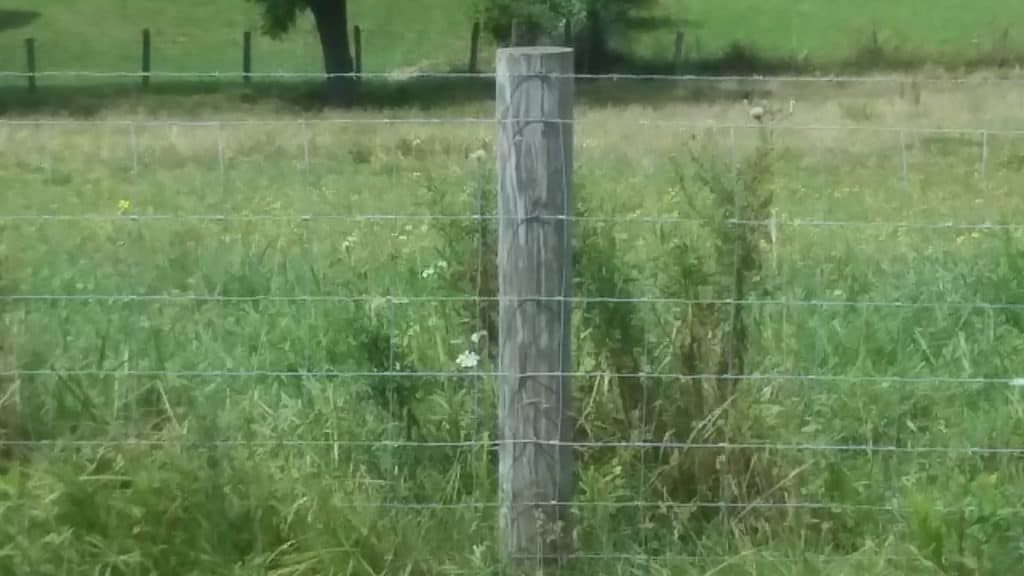
Woven wire fence for sheep has drawbacks
The first drawback to woven wire is the cost.
Per foot it is not overly expensive it is just that you have to put in the entire fence all at once and therefore pay all of the money the first year.
This means that all of the rest of the years using the fence are basically free, but that is because you put in all the money up front.
It’s worth the money overall, but that first year definitely hurts.
The second obvious drawback to woven wire is that the fence is normally put in as a permanent line, so does not move later.
I say normally because I have only seen one person do it any other way.
We know of a hog farmer in southern Ohio who uses woven wire but redoes the paddock every year.
He pulls up the posts and all and movrd the pigs to a new area.
If I remember correctly he does quadrants around the barn using just one paddock per year and seeding down the one they just came out of.
He has a system that works well for him, but he’s the only one I’m aware of that uses woven wire as a non permanent fencing option.
Frequent flock moves? Go electric
How frequently you plan to move the sheep through a grazing rotation will play a role in what fencing you choose.
If you are choosing to set stock (keep the sheep in the same pasture the whole time, no rotating) then you don’t need to worry about portability.
However, it will be to your advantage to divide the pasture to let parts rest and regrow while just one part at a time feeds the sheep.
This is a bit more work, but in return for your work and planning you get many times more growth off of your pastured land, healthier animals since you will be breaking the parasite cycle and healthier plants and soil.
Not a bad trade off really.
If you are planning to move the sheep often the you will want a fencing option that is more portable and designed to be moved frequently.
Permanent fence is a one time cost
As mentioned above the cost for permanent fencing is high in the first year, but and that’s a big but there is no additional cost.
That one time expense will keep up with your stock for 30 years.
Electric fencing will be cheaper to get a hold of and cheaper to install but it will definitely not last any where near the 30 years!
The main part of the netting and polywire that makes it portable is the small wire threaded through plastic and being out in the sun and just regular use will cause the plastic to degrade and break over time.
This is not to warn you off of electric fencing, not at all. We love it and just bought 10 more rolls of netting because we use it everywhere.
I just want you to be aware that the netting is sturdy and lasts quite a while, meaning you will likely get years of use from it but not decades.
Have long term access to the land or use electric
Not everyone owns the land they graze their sheep on, actually some flock owners graze only land they do not own like grazing to keep down vegetation that would otherwise be a fire hazard.
These sheep and flock owners provide a very important service that has dual benefits for both state and the sheep owners, but this definitely means temporary movable fence and more than likely a solar or battery powered charger.
If you are interested in a great sheep grazing operation, meaning constant movement of sheep over someone else’s land, checkout Cud Crew.
For a different perspective on your options for sheep fencing, read Sheep 201: Fencing. Be sure to click around on this site, lots of good stuff here!
